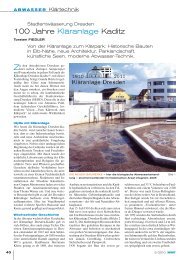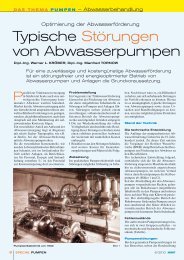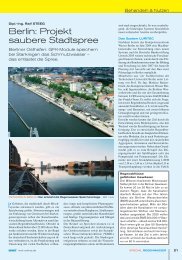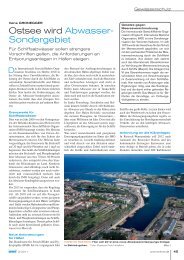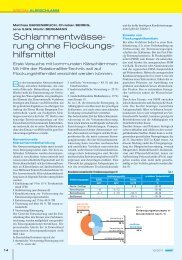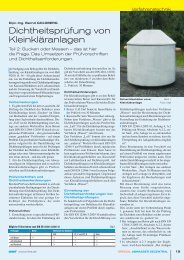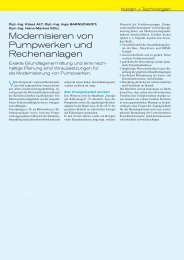international - wwt-online.de
international - wwt-online.de
international - wwt-online.de
You also want an ePaper? Increase the reach of your titles
YUMPU automatically turns print PDFs into web optimized ePapers that Google loves.
INDUSTRIAL WATER Mo<strong>de</strong>rn methods<br />
Cooling<br />
tower<br />
River<br />
Air<br />
Bleed<br />
Water<br />
treatmant<br />
Sludge<br />
Office<br />
Concentrate<br />
pre-treatmant<br />
Biological<br />
treatment<br />
Biomar ®<br />
Envopur<br />
reverse<br />
osmosis<br />
Complete process for water management Image 5<br />
the basis of crystalline silicon. These cells<br />
currently have the highest efficiency level,<br />
but are more expensive than solar cells produced<br />
on the basis of thin film technology<br />
on account of the raw material silicon and<br />
the more elaborate manufacturing process.<br />
In the course of the entire manufacturing<br />
chain, the first wastewater accumulates during<br />
the sawing of the mono silicon wafers.<br />
The individual thin silicon wafers are sawn<br />
from one mono silicon crystal. The aim is to<br />
produce wafers that are as thin as possible<br />
with a minimum of sawing loss. To cool the<br />
saws and ensure effective cutting, large<br />
quantities of water are used, or else mixtures<br />
of polyethylene glycol (PEG) and silicon<br />
carbi<strong>de</strong> (Novak, 2011). Here the objective of<br />
the wastewater treatment is to keep the water<br />
in circulation and to treat it in such a way<br />
High pure<br />
water production<br />
Water<br />
production<br />
Chemical<br />
Rins water<br />
treatmant<br />
Solids<br />
Concentrate<br />
Chemical<br />
Concentrate<br />
pre-treatmant<br />
Envochem ®<br />
evaporator<br />
Concentrate<br />
Water treatment Production<br />
Waste water treatment<br />
Cell<br />
production<br />
Concentrate<br />
Rins water<br />
treatmant/<br />
Envopur<br />
reverse<br />
osmosis<br />
Image 6<br />
Anaerobic<br />
<strong>de</strong>gradation<br />
of PEG and<br />
corresponding<br />
volumetric loading<br />
that it can be discharged. A particular challenge<br />
is the dissolved PEG, which remains<br />
in the wastewater. Depending on the chain<br />
length, PEG is only bio<strong>de</strong>gradable after a<br />
long retention time. Bio<strong>de</strong>gradability is <strong>de</strong>fined<br />
by means of the total parameter of<br />
biological oxygen <strong>de</strong>mand (BOD5). Here,<br />
bio<strong>de</strong>gradability in 5 days is <strong>de</strong>termined.<br />
For PEG with a greater chain length, the<br />
BOD5 is almost zero, but the value BOD30<br />
is almost 100%; in other words, PEG is almost<br />
completely <strong>de</strong>gradable after a retention<br />
time of 30 days. Municipal sewage treatment<br />
plants, however, are seldom <strong>de</strong>signed<br />
for these retention times or the related high<br />
sludge age. In small sewage treatment<br />
plants, therefore, high loads of PEG are either<br />
not <strong>de</strong>gradable, or not <strong>de</strong>gradable to a<br />
satisfactory <strong>de</strong>gree.<br />
In an initial stage, solids are removed from<br />
the highly contaminated organic wastewater<br />
that has been collected. The chemicalphysical<br />
process of precipitation/flocculation<br />
has proved reliable here. The subsequent<br />
filtrate then contains only the dissolved organic<br />
components. The anaerobic Biomar ®<br />
technology is suitable for biological treatment.<br />
In high performance reactors, the total<br />
parameter COD of the organically highly<br />
contaminated wastewater is effectively reduced<br />
(Image 6).<br />
Besi<strong>de</strong>s biological oxygen <strong>de</strong>mand, chemical<br />
oxygen <strong>de</strong>mand (COD) is also used as a<br />
total parameter for assessing wastewater.<br />
The diagram above shows the results obtained<br />
in an EnviroChemie pilot plant. An<br />
elimination range of up to 98 % was<br />
achieved for COD, with a steady rise in<br />
volumetric loading. At the same time, biogas<br />
is produced as an energy source material.<br />
Summary<br />
Energy production from solar energy by<br />
means of solar cells will become increasingly<br />
important in future. This environmentally<br />
friendly technology, however, generates<br />
wastewater with differing contamination<br />
levels, <strong>de</strong>pending on the manufacturing<br />
process.<br />
However, water is becoming an increasingly<br />
valuable raw material. For this reason, toxic<br />
contents must be eliminated and water recovered.<br />
Precipitation and adsorption methods<br />
will be used for this, accompanied by<br />
methods involving the biological treatment<br />
of sewage (anaerobic/aerobic) and membrane<br />
processes for recycling rinse water.<br />
Besi<strong>de</strong>s the recirculation of water, the recovery<br />
of valuable materials from the production<br />
process is becoming increasingly important<br />
in or<strong>de</strong>r to preserve resources. Here,<br />
EnviroChemie is working intensively on<br />
innovative techniques as part of research<br />
projects.<br />
REFERENCES<br />
/1/ Hartinger, L. (1991). Handbuch <strong>de</strong>r Abwasser und<br />
Recycling-Technik für die metallverarbeiten<strong>de</strong><br />
Industrie. 2. Auflage, Carl Hanser Verlag München<br />
Wien, (unverän<strong>de</strong>rter Nachdruck 2007)<br />
/2/ Novak, O. (2011). Abwässer aus <strong>de</strong>r Photovoltaikindustrie<br />
und ihr Einfluss auf die Kommunale<br />
Abwasserreinigung. Tagungsband DWA<br />
WasserWirtschafts-Kurs N/5 – Behandlung von<br />
Industrie- und Gewerbeabwasser, März 2011<br />
CONTACT<br />
Elmar BILLENKAMP<br />
EnviroChemie GmbH<br />
In <strong>de</strong>n Leppsteinswiesen 9 | 64380 Rossdorf<br />
Tel.: 06154/699858<br />
E-Mail: elmar.billenkamp@envirochemie.com<br />
18 INTERNATIONAL<br />
2011





